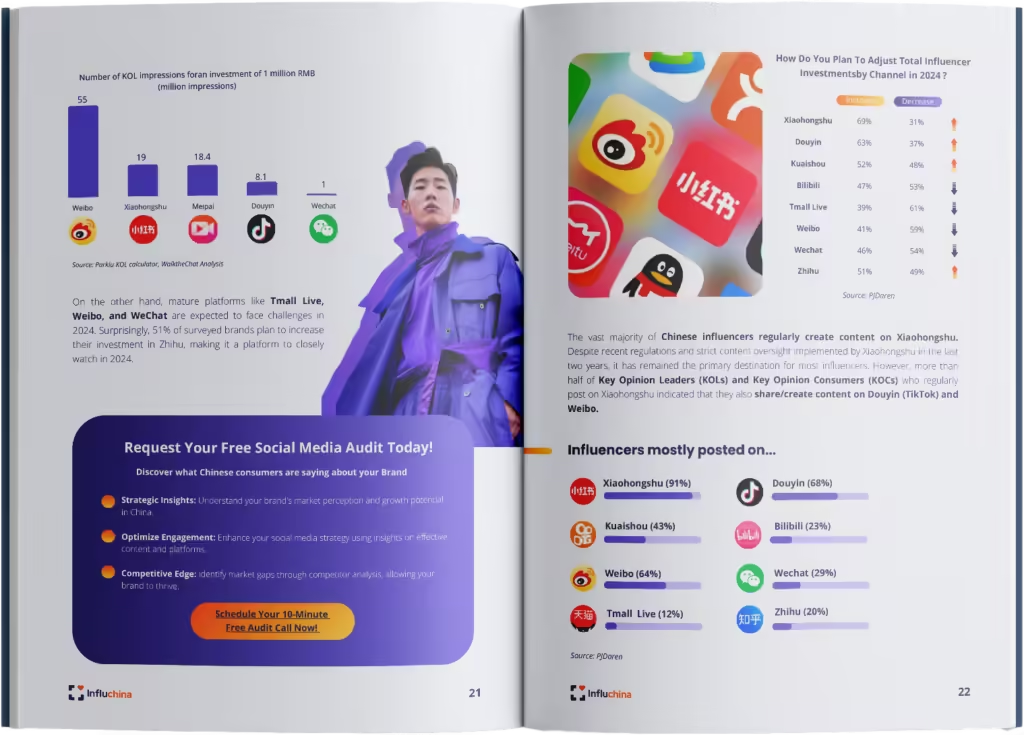TL;DR | KOC & KOL Marketing China
(2025 Guide & Insights)
KOL (Key Opinion Leader) and KOC (Key Opinion Consumer) marketing are the two driving forces behind China’s influencer economy — a market projected to exceed CN¥6.7 trillion by 2025. KOLs build large-scale awareness through professional, high-reach content, while KOCs foster authenticity and trust through relatable, peer-level recommendations.
Success in China’s fast-moving digital landscape comes from balancing both approaches across platforms like Douyin, Xiaohongshu, WeChat, and Weibo. For foreign brands, partnering with a local agency such as InfluChina ensures verified influencer selection, cultural localisation, and measurable ROI — turning influence into long-term brand growth.
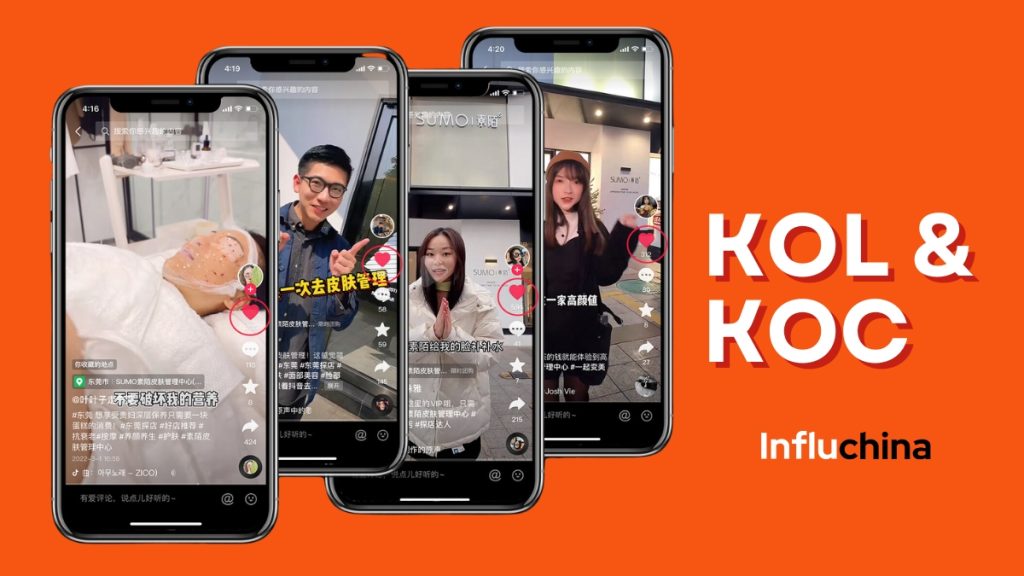
Knowing what KOL (Key Opinion Leader) and what KOC (Key Opinion Consumer) are is essential to break into the Chinese market. These two terms, which, as we will see, refer to two types of influencers, have become increasingly important in the marketing strategies of any business interested in having a presence in the Chinese market.In fact, understanding their roles is a critical component of any successful China market entry strategy.
This growth has been accelerated by the Covid-19 pandemic and the resulting prevention measures, such as physical shop closures, dinners, in-person events and sporadic district closures. These measures have led to a significant increase in the amount of time Chinese consumers spend on the Internet.
In fact, chinese consumer now spends more than seven hours a day on the internet, and abaout tho-thirds of those seven hours are spent using social networks or content applications, as users increasingly seek information about the world around them through social networks, about influencers, friends and to make purchasing decisions.
Therefore, knowing what KOL and KOC are is essential knowledge for effective social media marketing in China. In addition to discussing the specifics of each, we will also look at the main differences between the two.
KOL marketing and KOC marketing have become increasingly important in the overall marketing strategies of any company that wants to promote their business in China and successfully penetrate the Chinese market.
1. What Is KOL Marketing in China?
KOLs (Key Opinion Leaders) are influencers in China whose opinions and lifestyles play a crucial role in shaping the purchasing decisions of Chinese consumers. As an integral part of any China marketing strategy, KOLs are considered wise and knowledgeable on Chinese social networks, and their recommendations are perceived as highly authentic and trustworthy.
Their main function is to increase a brand’s visibility and sales of its products and services. They achieve this thanks to their position, the huge follower base they have and the trust placed in them.
KOLs are social media celebrities, who are specialized in a certain sector or topic, so their recommendations and opinions are considered genuine and impartial. This is particularly powerful in influencer marketing for luxury brands, where exclusivity, credibility, and aspirational identity are key to attracting high-end Chinese consumers.
The main function of KOLs in China is to increase the visibility of a brand, improve its reputation and branding, which they achieve thanks to the influence they carry within their communities and large base of followers.
According to the National Bureau of Statistics, China’s influencer economy grew from CN¥241.9 billion (US $38.5 billion) in 2018 to CN¥1.3 trillion (US$210 billion) in 2020. It is estimated that by 2025, the total market size of China’s influencer economy will reach CN¥6.7 trillion (US$1.035 trillion).
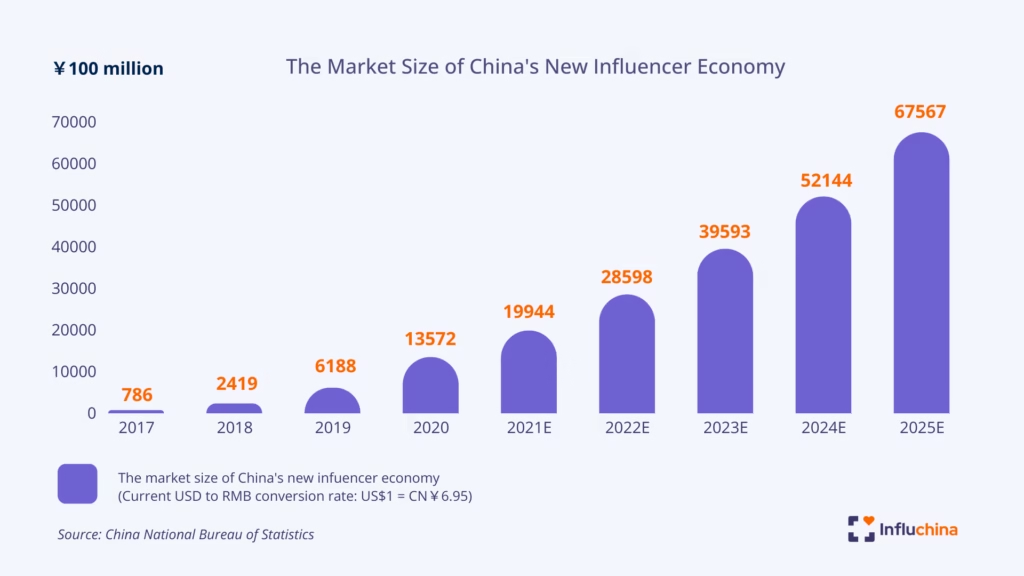
China has redefined the game, turning influencer marketing into a high-level sport. This is demonstrated by the fact that the value of the market reached a staggering US$13.8 billion in 2023, with a year-on-year growth of 16.3%.
Another very important piece of data to understand the influencer marketing market is the fact that 74% of Chinese consumers evaluate and make purchasing decisions based on influencer recommendations, compared to only 30% in the rest of the world, so the relevance of influencers is understandable.
Furthermore, according to a May 2023 survey of nearly 7,000 respondents in China, 86% said they have made purchases after being recommended a product by an influencer.
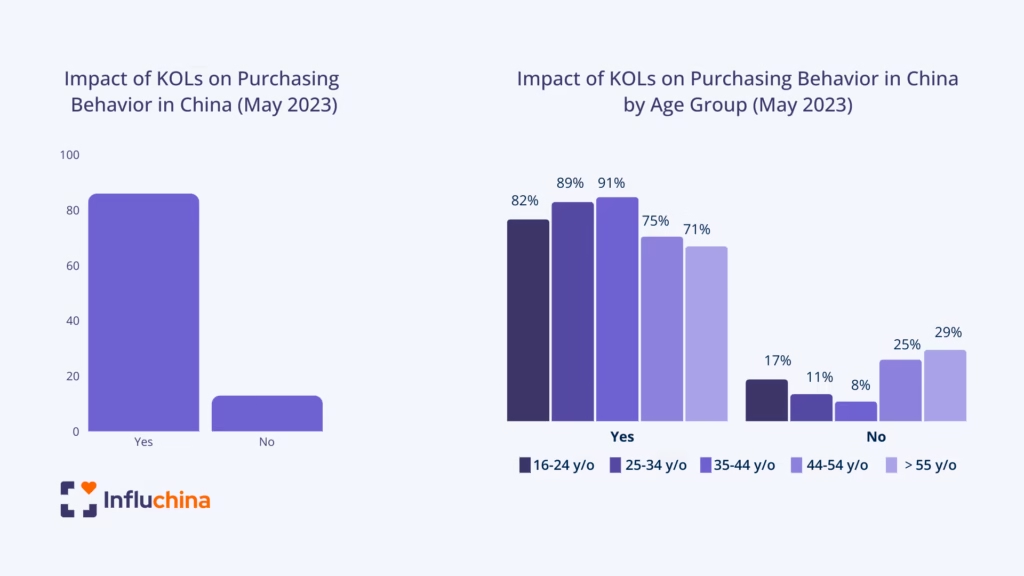
74% of Chinese consumers evaluate and make purchasing decisions based on influencer recommendations, compared to only 30% in the rest of the world.
1.1 Why KOL Marketing Has Become Essential for Brands in China
Despite difficult macroeconomic conditions and the restrictive effects of China’s Covid zero policy, influencer marketing remains the number one marketing investment for most brands in China. 58% of brands surveyed reported spending more on influencer marketing between October 2021 and September 2022 than during the same period last year.
Importantly, 48% of brands reported that their organisations’ influencer marketing teams had increased because of KOL in China. In addition, 28% of brands reported having more than 5 team members dedicated to executing influencer marketing campaigns.
28% of brands reported having more than 5 team members dedicated to executing influencer marketing campaigns.
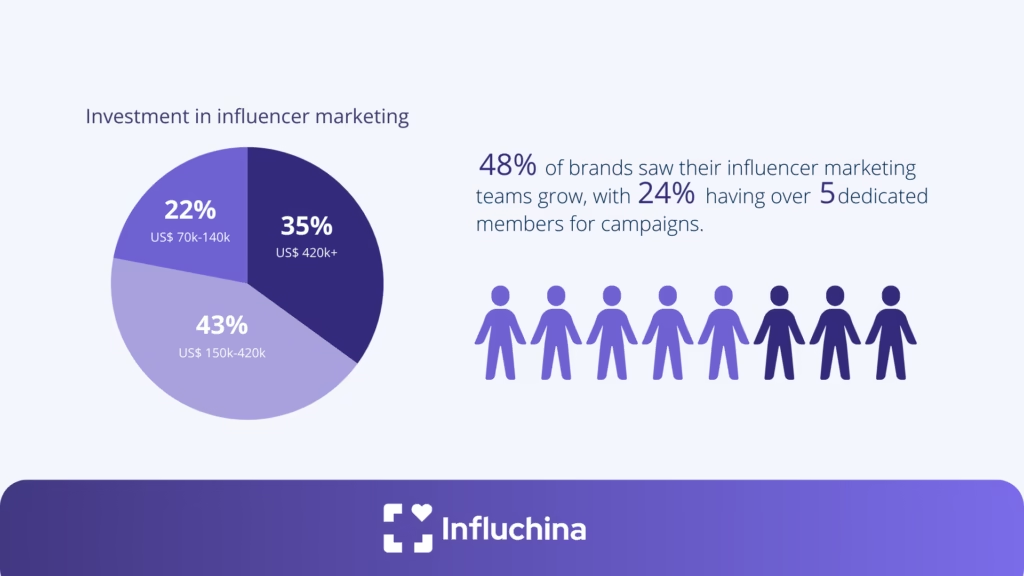
Top Social Media Platforms for KOL Marketing in China
Now that we have covered what KOLs are and their main functions, let’s take a look at their importance on Chinese social media. KOLs exert their influence across major platforms such as WeChat, Weibo, Little Red Book, Douyin, and Kuaishou, where they collaborate with brands to promote products and services in impactful ways.
Another way for KOLs to promote themselves on Chinese social networks is through live broadcasts, a tool that has become very popular in recent years, known as live streaming. Check here to know more about China streaming platforms.
To successfully navigate this evolving landscape and fully leverage the potential of KOLs, partnering with a KOL marketing agency in China can be invaluable. With the right expertise, you can maximize the impact of your campaigns and drive meaningful results.
KOLs can promote products through live streams, where users can purchase directly from the stream on TikTok or Kuaishou.
Let us now look at the most effective social networks for this purpose:
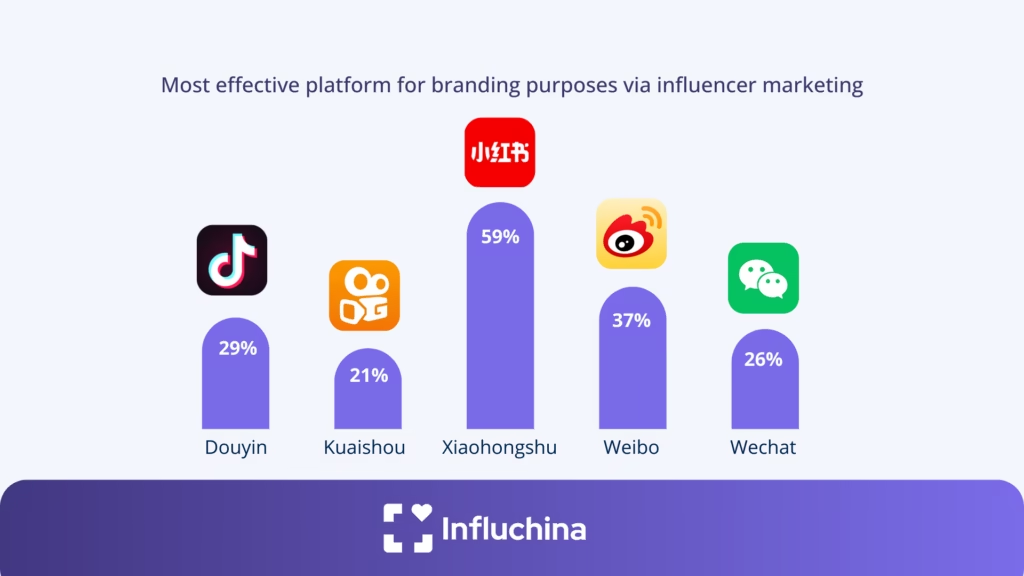
When it comes to brand building and awareness, Xiaohongshu marketing delivers the best results. In fact, 59% of brands identified Xiaohongshu as the platform where they have experienced the greatest impact in terms of branding. Meanwhile, 37% of brands selected Weibo as the second-best platform for branding activities.
Also widely known as Rednote, Xiaohongshu has gained recognition not only in China but also among international marketers looking to tap into a visually rich, trust-driven content ecosystem. As a result, Red Note marketing is becoming a key strategy for brands aiming to build awareness and credibility with younger, experience-driven consumers.
However, it is Xiaohongshu, Douyin and Kuaishou that led the way for new influencer campaigns by brands in 2023. As China’s e-commerce continues to decentralise, brands are more confident to explore less traditional platforms.
On the other hand, mature platforms such as Tmall Live, Weibo and WeChat are expected to face a challenging 2024. Surprisingly, 51% of brands surveyed plan to increase their investment in Zhihu, making it a platform to watch closely in 2024.
51% of brands surveyed plan to increase their investment in Zhihu, making it a platform to watch closely in 2024.
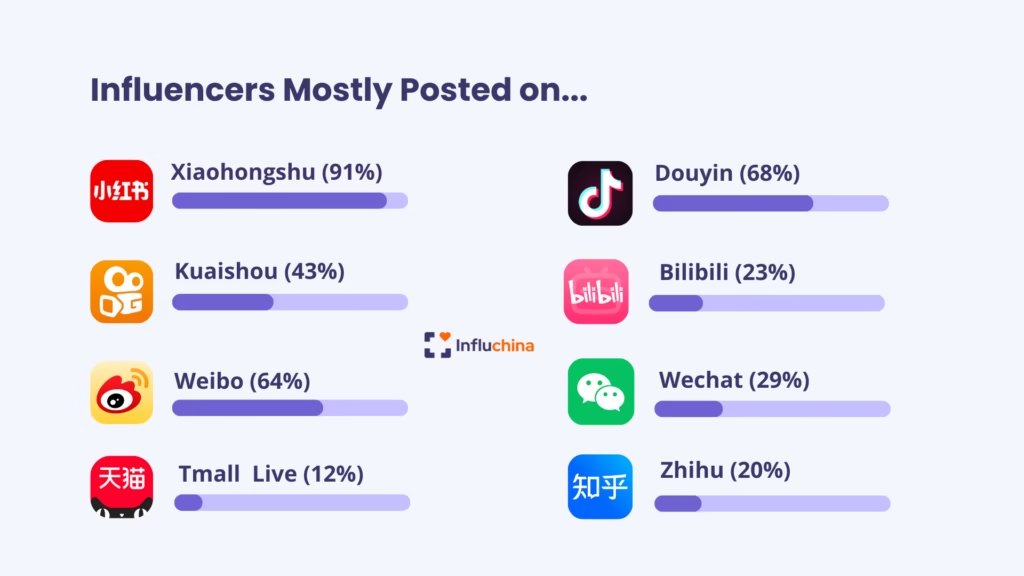
The Influencers Mostly Posted data shows that Xiaohongshu influencers dominate at 91%, highlighting the platform’s strength in lifestyle and beauty content. This makes it a key choice for campaigns focused on authenticity and engagement. To fully leverage these opportunities, partnering with a Xiaohongshu agency can provide the specialized knowledge needed to design campaigns that align with the platform’s strengths. From refining your influencer strategies to ensuring your campaigns resonate within Xiaohongshu’s unique content ecosystem, the right agency can help maximize the impact of your Xiaohongshu marketing efforts while driving real results.
The success of brand campaigns relies on leveraging the right levels of influencers to achieve key goals such as brand building, market development, and conversion—all critical elements for meeting campaign objectives. For a detailed breakdown of these insights, we recommend downloading our China Influencer Marketing Insights Report.
6 Key Tips When Collaborating with KOLs in China
- When collaborating with KOLs in China, it is essential to keep in mind that there is a big difference between Western and Chinese platforms, so it will be necessary to adapt your influencer marketing strategy to the Chinese market.
- In-depth knowledge of the main Chinese social networks (Douyin, Xiaohongshu, Toutiao, Kuaishou, WeChat, etc.) is essential for an effective campaign.
- It is crucial to analyze the trends in KOL collaborations that are emerging in the Chinese market thoroughly.
- When you are looking to engage in influencer marketing in China, keep in mind that many of these influencers may have fake followers, so you need to examine the interaction generated by the KOL’s content before making a misstep.
- It is important to try to avoid collaborating with a key opinion leader in China who is already endorsing several brands, to ensure that your brand has sufficient visibility.
- It is imperative to have a clear and concise campaign briefing, providing detailed information to the KOL on objectives, content requirements, guidelines on what products or services you want to promote, and how.
Before starting a collaboration with a Chinese KOL, you should take into account important aspects such as: the difference between Western and Chinese platforms, characteristics of Chinese social networks, market trends, "fake KOLs" and make sure you have a clear briefing.
Want to Learn More About Influencer Marketing in China?
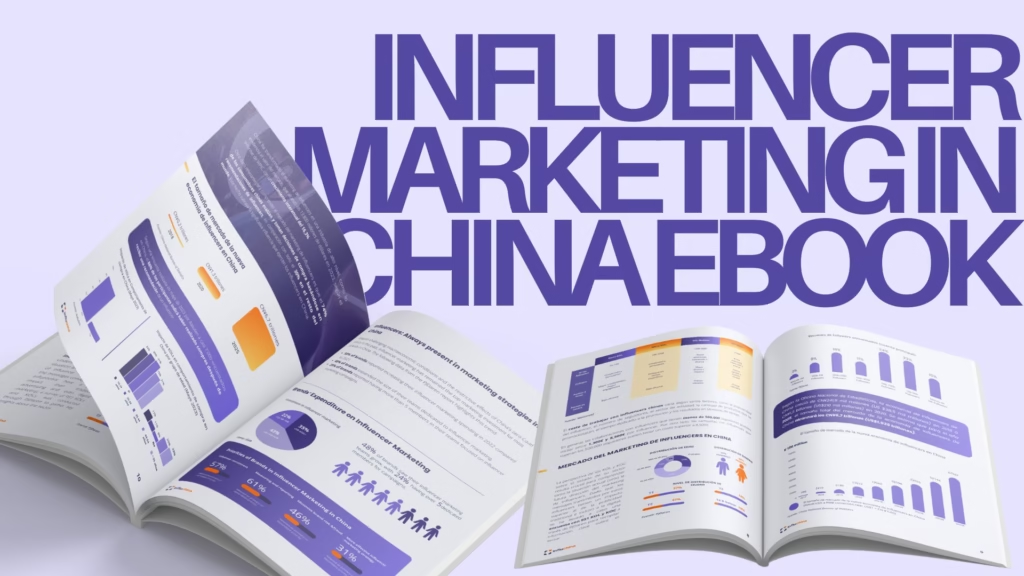
Download our free eBook on influencer marketing in China—packed with platform insights, campaign tips, and real examples to help you get started with confidence.
2. How to Find Verified KOLs and KOCs in China
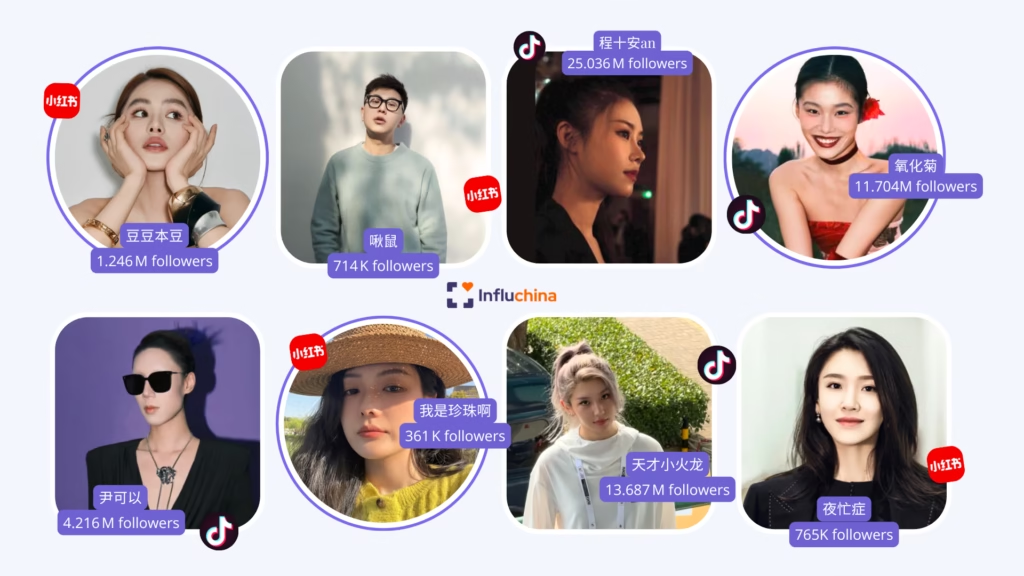
2.1. Use Official Collaboration Platforms
China’s major social networks provide dedicated systems for brand-influencer collaboration:- Xingtu (Douyin, Toutiao, Xigua): Xingtu is the official platform to engage with Chinese influencers on networks such as Douyin, Xigua and Toutiao. To access the platform, you must complete a multi-stage registration and have a Chinese company. Xingtu can do things like receive orders, manage the recruitment of Chinese influencers, summarise projects and view data once you log in.
- Pugongying (Xiaohongshu): Xiaohongshu created Pugongying, a platform where brands can work with Chinese influencers to promote their products or services. This collaboration can take the form of text, images or videos. To use the platform, the company must register in China. Once the influencer has entered, a proposal must be submitted for acceptance and communication is established.
- Weirenwu (Weibo): Weirenwu is the official online advertising platform for Chinese influencers on the social network Sina Weibo. Comedy, food, entertainment and live broadcasting are just some of the areas of influence.
2.2. Partner With a Local KOL Marketing Agency
Foreign brands without a Chinese business license can streamline operations by partnering with a specialist agency such as InfluChina. A local agency manages influencer vetting, negotiation, payment, and reporting — and often has direct access to verified creator databases that bypass inflated pricing or fake followers.2.3. Conduct Data-Based Vetting
Before finalising collaborations:- Review follower authenticity and engagement rates
- Analyse audience demographics and content quality
- Avoid influencers who promote multiple competing brands
Pro Tip: InfluChina maintains a curated database of high-quality KOLs and KOCs across Douyin, Xiaohongshu, WeChat, and Weibo — ensuring every collaboration aligns with your brand’s objectives and delivers measurable ROI.
3. What Is KOC Marketing in China?
It is true that KOLs in China have established themselves as an important social media marketing tool, but in recent years there has been a shift from KOLs to the use of KOCs (Key Opinion Consumers) in marketing strategies in the Chinese market.
The main reason is that KOCs are considered to be more reliable than KOLs and have greater persuasive power than major influencers.
KOCs (Key Opinion Consumers) are consumers who personally promote a company’s products through their reviews. In their choices, they tend to be very selective about what they are willing to recommend and review as reliable and trustworthy information.
Although most of them do not have a very high number of followers, especially compared to KOLs, they are essential for consumers to make purchasing decisions, in addition to the fact that ordinary people identify more easily with them than with KOLs.
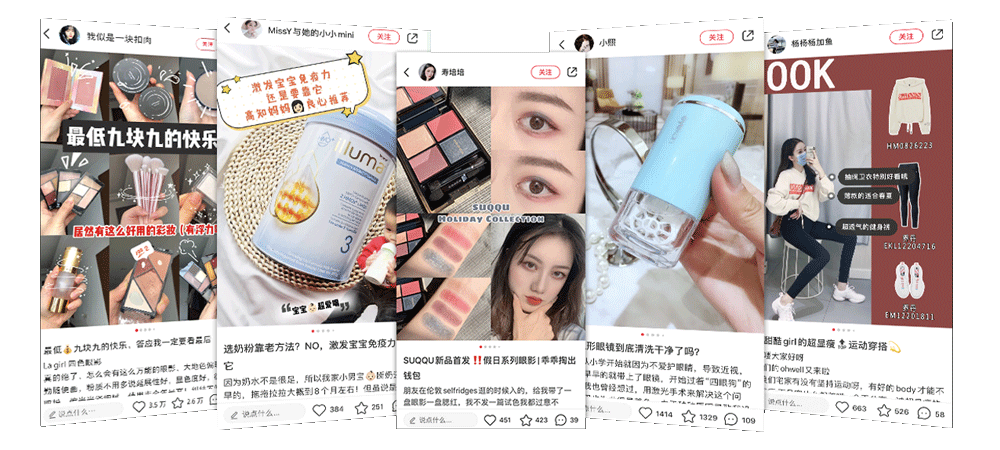
KOCs (Key Opinion Consumers) are consumers who personally promote products through reviews. They are considered more trustworthy than KOLs, with a smaller but more loyal community and, in recent years, are undergoing a remarkable growth in influencer marketing in China.
3.1 How to Leverage KOC Marketing in China (Step-by-Step)
To leverage KOC partnerships in China, brands have a number of ways to reach the target audience and exponentially increase sales, a goal they can achieve by following a few simple but important steps:
- Define your objectives: the goal of collaboration with a KOC is to increase sales and build a reputation, given their high power of conviction, so it is more important to select an influencer with relevance to the company than one with a large following that is not as profitable.
- Choose the right platforms: Chinese social networks, such as Little Red Book, Weibo or Douyin, effectively promote KOC content through their complex algorithms, so brands can make use of these platforms to leverage user-generated content and KOCs.
- Prepare your products and services: before starting the collaboration, make sure your products are in top condition.
- Expert guidance: Those with expertise in influencer marketing in China can help you with the implementation of your strategy. For this, InfluChina, a social media agency that is dedicated to promoting tourism to businesses through strategic collaborations with influencers, is a smart choice.
- Search Engine Optimization (SEO) on Chinese social networks: In this case, the most attractive and effective social networks are Xiaohongshu, WeChat, Toutiao and Weibo.
- Boost the reputation and credibility of the brand or product through personalized reviews with high persuasive power, a strategy that is especially effective with advertising in Xiaohongshu, as the platform’s users highly value authentic and relatable content that builds trust and engagement.
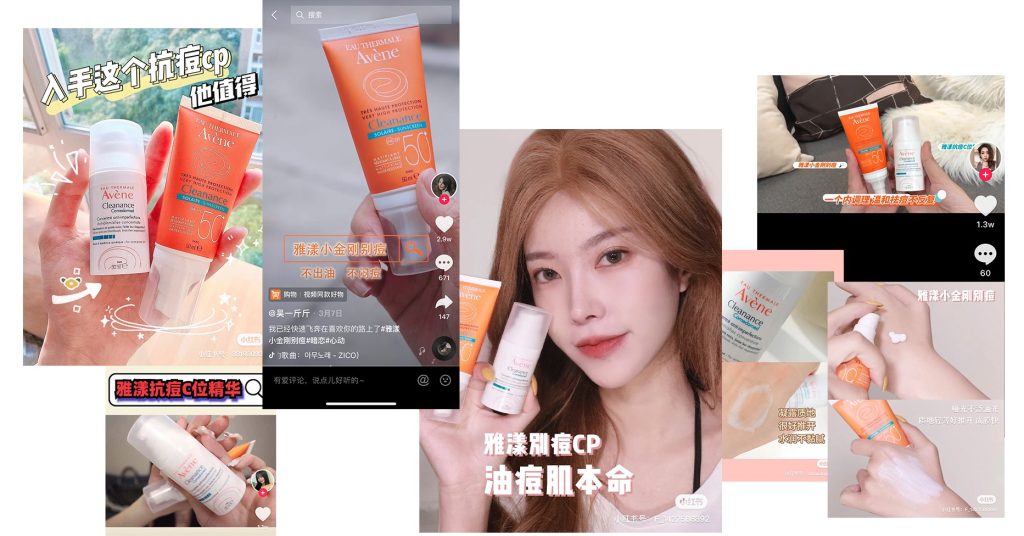
In order to receive professional guidance on penetrating the Chinese market, InfluChina is a wise choice to help you implement the best possible influencer marketing strategy.
3.2 Types of KOC Marketing in China
As for the types of KOC marketing, there are different kinds, each with its advantages and disadvantages. Some of these are:
- Superuser-generated content: Superusers are people with high brand loyalty and active online presence. They tend to be interested in sharing innovative and creative ideas, so brands can leverage them to increase their visibility and engagement in the Chinese market.
- Create a persona that acts as a KOC: This is a strategy with a creative approach, where a relatable and authentic character is created, who shares their day-to-day life, interests, care, routines, etc. on Chinese platforms.
There are mainly two types of KOC marketing: Superuser-generated content and the creation of a character that acts as a real KOC.
4. What Is the Difference Between KOL and KOC in China?
First of all, we can draw out some of the differences between KOC and KOL in China.
Level of influence and reach
KOLs are highly influential figures in Chinese social media, often regarded as authoritative voices in their respective niches. Their opinions and lifestyles significantly impact the purchasing decisions of consumers due to their perceived authenticity and expertise. They possess a large fan base and are able to drive substantial visibility and sales for brands.
KOCs are everyday consumers who promote brand products through personal reviews and recommendations. Unlike KOLs, KOCs have a smaller following but are trusted for their relatable and authentic perspectives. Their influence stems from the genuine, consumer-like approach they bring, making them effective in shaping purchasing decisions.
Role in marketing strategies
The primary role of KOLs in marketing is to boost brand visibility and drive sales. They leverage their significant social media presence and trustworthiness to endorse products and services. Brands collaborate with KOLs to reach a wide audience quickly and effectively, capitalizing on their celebrity status within specific sectors.
KOCs focus on providing reliable and trustworthy reviews of products, often based on personal experience. Their role is crucial in the decision-making process for consumers who seek genuine feedback. Marketing strategies involving KOCs emphasize authentic consumer insights over broad visibility, catering to an audience that values relatable endorsements.
Perception of authenticity
KOLs are perceived as authentic due to their specialized knowledge and disinterested recommendations. Their endorsements are seen as credible because of their expertise and established reputation in particular fields, whether it be beauty, technology, or fashion.
KOCs’ authenticity comes from their status as regular consumers. Their recommendations are valued for being genuine and relatable, as they are seen as unbiased and not commercially motivated. This relatability makes their opinions highly trusted among their followers.
Engagement with followers
KOLs engage with their audience on a larger scale, often interacting through high-profile social media platforms and public appearances. Their engagement tends to be more formal and professional, aligned with their celebrity status and large following.
KOCs interact with their followers in a more personal and relatable manner. Their engagement is typically through informal channels, such as personal social media posts and direct interactions, making their connection with followers feel more intimate and trustworthy.
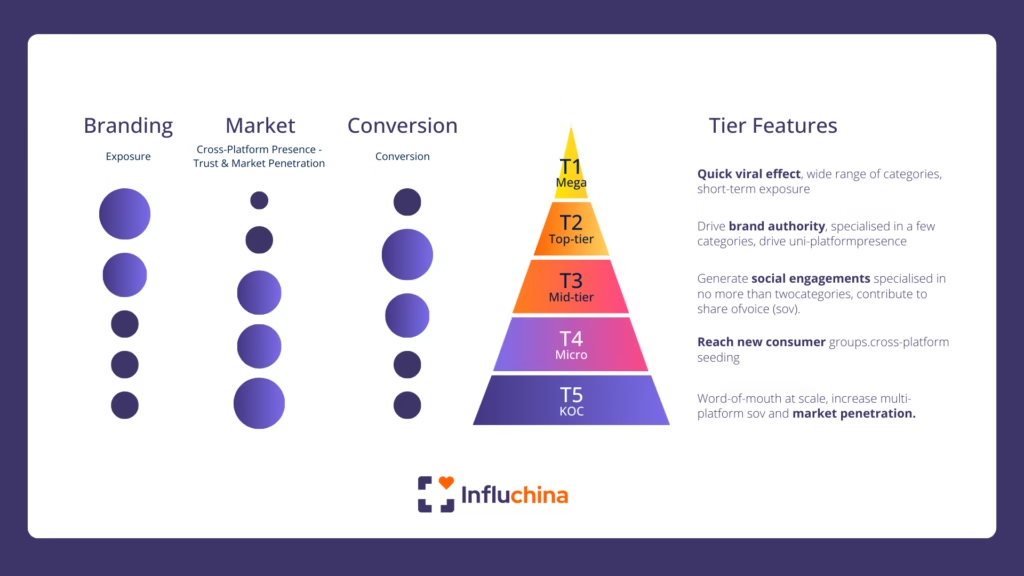
Comparison of KOC and KOL
Category | KOL | KOC |
Who they are | Social media experts with large follower base | Consumers who promote, personally test, and review products and services |
Objective | To increase a brand’s visibility, sales, and brand awareness | To offer personalized and authentic reviews |
Ideal for | Brands that want visibility and reach | Brands that want conversion |
Advantages | Great reach and defined niche | People identify with them and greater reliability |
Disadvantages | Less credibility. Higher cost. | Lower reach. Requires collaboration with several profiles to generate impact. |
Number of followers | >30,000 | <30,000 |
Effectiveness of KOL Sizes and Social Media Platforms by Marketing Objectives
To visualise how KOLs and KOCs perform across different marketing goals — branding, conversion, and market penetration — the following chart highlights the relative effectiveness of influencer tiers (from Mega KOLs to KOCs) across China’s key platforms: Weibo, RedNote (Xiaohongshu), Douyin, and WeChat.
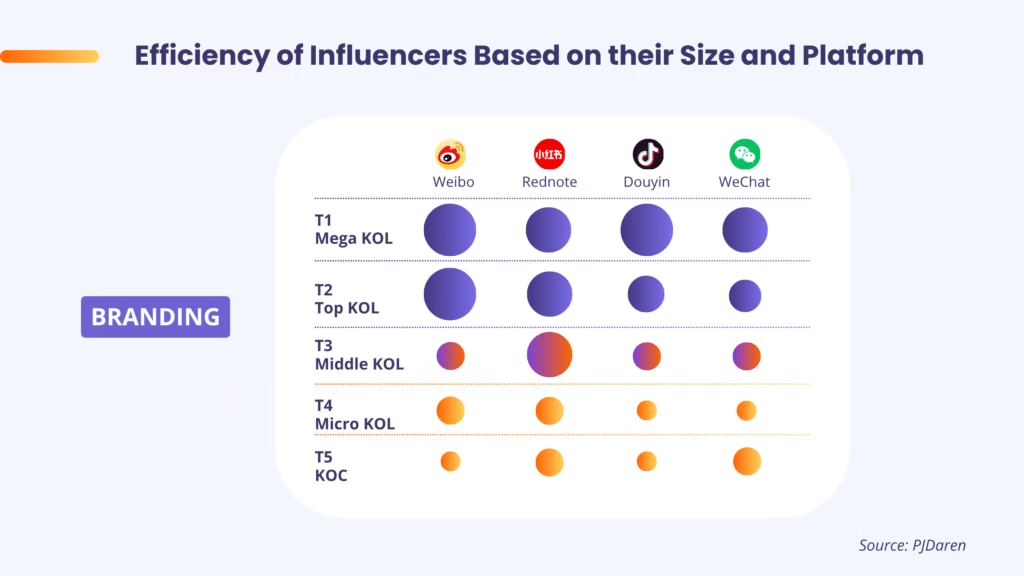
Branding — Visibility and Aspiration through Mega & Top KOLs
Mega and Top-tier KOLs remain unmatched when it comes to brand visibility, awareness, and aspirational positioning. Platforms like Weibo and RedNote (Xiaohongshu) lead this stage, as users there seek inspiration, lifestyle cues, and authority figures.
On Weibo, celebrity-level influencers dominate large-scale brand storytelling, especially for luxury, automotive, and fashion campaigns.
On RedNote, Top KOLs create high-trust, aspirational content that feels authentic—perfect for brands seeking soft-sell awareness through storytelling and aesthetic visuals.
These KOLs are ideal when launching new products, rebranding, or entering the Chinese market for the first time.
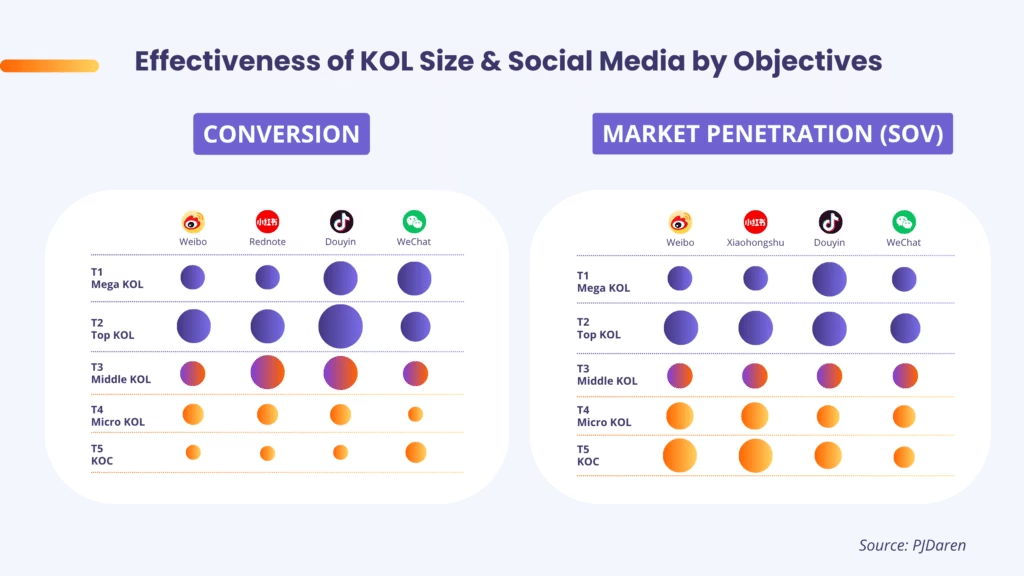
Conversion — Storytelling and Action on Douyin
When the goal is driving sales and measurable conversions, Middle-tier and Micro KOLs on Douyin are the key drivers.
Their smaller audiences allow for more engaged and loyal communities, making product recommendations more convincing.
Douyin’s livestreaming format amplifies urgency through limited-time offers and real-time Q&A, resulting in extremely high click-to-buy rates.
Content styles like tutorials, day-in-the-life, and transformation videos perform best for FMCG, beauty, wellness, and fashion products.
Douyin is the platform where entertainment meets commerce — short-form storytelling converts views into purchases faster than any traditional eCommerce funnel.
Market Penetration (SOV) — Sustained Engagement through Micro KOLs & KOCs
Building long-term share of voice (SOV) in China’s crowded digital landscape requires consistency and trust—areas where Micro KOLs and KOCs shine.
On WeChat, KOCs drive word-of-mouth through private groups, mini-programs, and Moments posts, reinforcing brand credibility over time.
On RedNote, their UGC-style reviews strengthen SEO-like discoverability, helping brands stay top-of-mind during the research and consideration phase.
Because their content is perceived as organic and unpaid, KOCs are especially effective for product seeding and long-tail visibility.
For sustained influence, brands should maintain an ongoing base of KOC collaborations, not just one-off campaigns.
The Optimal Mix — Combining Reach with Authenticity
While Mega KOLs deliver awareness and traffic spikes, it’s often the Micro and KOC layer that ensures steady growth and genuine advocacy.
A hybrid influencer strategy that blends Top-tier KOLs for mass visibility with Micro/KOCs for authenticity and niche penetration is the most effective way to achieve:
Broader reach across demographics and regions
Deeper consumer trust through real-use reviews
Long-term visibility through continuous organic sharing
How Much Do KOL Collaborations Cost on RedNote and Douyin?
After discussing how influencer size and platform affect visibility and engagement, it’s important to understand how these differences translate into cost. The following table compares average collaboration prices, engagement rates, and ideal campaign use cases for Xiaohongshu and Douyin — two of China’s most impactful influencer marketing platforms.
Comparison of RedNote vs Douyin KOL Costs (2025)
KOL Tier (Followers) | Rednote – Avg. Cost | Rednote – Avg. Engagement Rate | Douyin – Avg. Cost | Douyin – Avg. Engagement Rate | Best Use Cases |
Mega KOL (Over 5M) | CN¥200k–380k (≈US$28k–53k) | 2%–4% | CN¥500k–1M (≈US$70k–140k) | 1%–3% | National brand awareness, luxury campaigns |
Top KOL (1M–5M) | CN¥120k–200k (≈US$17k–28k) | 3%–5% | CN¥250k–500k (≈US$34k–70k) | 2%–4% | Product launches, viral brand storytelling |
Mid KOL (300k–1M) | CN¥70k–120k (≈US$9.5k–17k) | 5%–7% | CN¥100k–250k (≈US$14k–34k) | 4%–6% | Lifestyle & beauty demos, livestream tie-ins |
Micro KOL (30k–300k) | CN¥30k–70k (≈US$4.2k–9.5k) | 6%–9% | CN¥50k–100k (≈US$7k–14k) | 5%–8% | Niche communities, product reviews |
KOC / Nano (Under 30k) | CN¥3.5k–30k (≈US$500–4.2k) | 8%–12% | CN¥4.5k–20k (≈US$625–2.7k) | 7%–10% | UGC, authentic reviews, local seeding |
(Source: PJDaren, 2024)
5. How Big Is China’s Influencer Market in 2025?
The influencer marketing landscape in China continues to grow at an extraordinary pace.
According to the National Bureau of Statistics, China’s influencer economy expanded from CN¥241.9 billion (US $38.5 billion) in 2018 to CN¥1.3 trillion (US $210 billion) by 2020 — a five-fold increase in just two years.
Industry forecasts project the market to reach CN¥6.7 trillion (US $1 trillion) by 2025.
This growth reflects how deeply social media has become embedded in daily life: over 1 billion Chinese consumers use platforms such as Douyin, Xiaohongshu, and WeChat every day.
Research shows that 74 % of consumers make purchase decisions based on influencer recommendations — far higher than the 30 % global average — proving how crucial KOLs and KOCs are to brand success in China.
Data insight: In 2023 alone, the influencer sector generated US $13.8 billion in revenue with 16 % year-on-year growth, making it one of the fastest-expanding digital industries in the world.
6. Trends: The Future of KOL and KOC Marketing in China
Here are the top five trends shaping KOL and KOC marketing in 2025 and beyond:
-
Rise of KOC-Driven Authenticity
Consumers are increasingly turning to relatable, everyday reviewers. KOCs are becoming the most persuasive voices for lifestyle and beauty brands that depend on credibility and community trust. -
Livestream Commerce Dominance
Livestreaming remains the core sales driver on Douyin and Taobao Live. Top hosts can generate millions in turnover in a single session, making “shop-streaming” a must-use tactic for e-commerce campaigns. -
Integration of Social + E-commerce
Seamless purchase flows now exist directly within social apps — through Douyin Shops, WeChat Mini-Programs, and Xiaohongshu Storefronts — reducing friction from discovery to checkout. -
Emergence of Virtual & AI Influencers
AI-generated avatars are gaining traction among Gen Z audiences. These “virtual KOLs” offer scalable, brand-safe alternatives for content and product demos. -
Platform Diversification Beyond the Big Three
While Douyin, Xiaohongshu, and WeChat remain dominant, newer communities such as Zhihu and Bilibili are attracting niche, high-value audiences — especially in education, tech, and youth culture.
Forecast: By 2026, over 60 % of Chinese brands are expected to include both KOL and KOC activations in their annual marketing mix, combining reach with credibility for higher ROI.
7. Conclusions
Now we have a better understanding of what KOL and KOC are in China, as well as the great significance they hold for any company that wants to successfully enter the Chinese market, the most profitable market of all.
KOL and KOC marketing play a vital role in China’s digital ecosystem, helping brands connect with consumers through trust, credibility, and engagement. Combining large-scale KOL campaigns with authentic KOC content creates a balanced strategy that drives both visibility and conversion. As China’s influencer economy continues to expand, brands that localize their approach and work with verified creators are best positioned for sustainable growth.
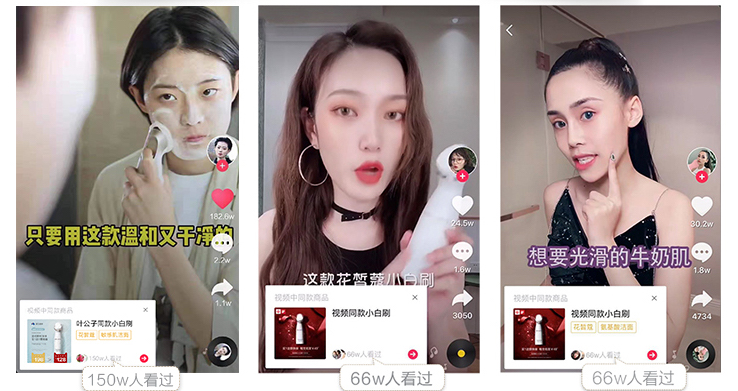
Work with a China Influencer Agency (Contact InfluChina)
If you are interested in strategic partnerships with KOLs in China or Chinese KOCs, you can contact InfluChina via hello@influchina.es, a social media agency that is dedicated to encouraging Chinese consumers to visit foreign businesses through strategic partnerships with Chinese influencers.
Influchina is a Hong Kong–based influencer marketing agency helping global brands collaborate with verified KOLs (Key Opinion Leaders) and KOCs (Key Opinion Consumers) across Douyin, Xiaohongshu, WeChat, and Weibo. From influencer selection and negotiation to campaign execution and ROI tracking, our team provides end-to-end support tailored to your objectives. Learn how we can help your brand grow in the Chinese market through authentic, data-driven influencer partnerships.
FAQ
Frequently Asked Questions about KOL and KOC Marketing in China
What does KOL stand for?
KOL stands for Key Opinion Leader. KOLs (Key Opinion Leaders) are Chinese influencers whose opinions and lifestyles are highly influential in the purchasing decisions of Chinese consumers.
What are KOCs?
KOCs (Key Opinion Consumers) are consumers who personally promote brand products through their reviews.
What is the difference between KOL and KOC marketing in China?
KOLs (Key Opinion Leaders) are professional influencers with large audiences who enhance brand visibility.
KOCs (Key Opinion Consumers) are everyday users who share genuine product reviews.
KOLs create reach; KOCs create trust. The most effective campaigns use both.
How can I collaborate with a KOL in China?
If you are interested in strategic collaborations with KOLs or KOCs, you can contact InfluChina.
Which platforms are best for KOL and KOC marketing in China?
Douyin, Xiaohongshu, and WeChat are the top platforms.
Douyin excels in video and livestream sales, Xiaohongshu in lifestyle and authentic reviews, and WeChat in private-community engagement.
How much do KOL collaborations cost in China?
Nano and micro KOLs (1K–100K followers) usually cost €500–€3,000 per post, while macro influencers (500K+) start around €5,000 and above.
Prices vary by platform, deliverables, and seasonality.
How can foreign brands find verified KOLs or KOCs?
Brands can use official collaboration tools like Xingtu, Pugongying, or Weirenwu, which require a registered Chinese entity, or work with a local agency such as InfluChina that handles compliance, negotiation, and payment.
Are KOCs more effective than KOLs for small brands?
Yes — KOCs often outperform KOLs for smaller brands because their content feels genuine and personal.
Their smaller but highly engaged communities can deliver higher conversion rates.
What trends are shaping KOL and KOC marketing in 2025?
Expect continued growth in livestream commerce, AI-generated influencers, and the integration of Douyin Shops and WeChat Mini Programs, which streamline the path from content to purchase.
Why should brands work with a China KOL agency like InfluChina?
Because local agencies provide verified influencer access, manage cultural localisation, and ensure ROI tracking across multiple Chinese platforms — making cross-border campaigns efficient and compliant.

